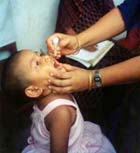



Polio is a disease that has lifelong health consequences for those infected. The poliovirus is of particular concern to public health because it spreads easily - it can circulate without causing symptoms for weeks, and so can travel great distances, entering polio-free areas by land, sea or air travel.
Although the world was hoping to eradicate polio through vaccination programmes, the disease has re-emerged because of inadequate control. In 2003, the government in Nigeria decided to stop vaccinating children in parts of the country. This resulted in a large outbreak of polio that spread not only throughout Nigeria but also to previously polio-free countries in Africa, Asia and the Middle East. Outbreaks continued to emerge until 2006.
To minimize the risk of polio entering their territory, countries are protecting themselves by vaccinating most or all of their population and by remaining alert. Polio, along with smallpox, SARS, and new influenza subtypes, is one of the four internationally notifiable diseases named in 2005 international health regulations and every single case of poliomyelitis caused by poliovirus not derived from a vaccine must be reported. In addition, there is a wide network that surveys the world to pick up any outbreak. The polio network is also used to analyse other diseases that are likely to cause epidemics but can be prevented through vaccination. Examples include influenza, measles, meningitis, rubella, and yellow fever.
A safer world, therefore, needs all countries to remain alert and ready to respond to any outbreak effectively and in a coordinated way. This is vital to rid the world of polio and to guard against the accidental or deliberate release of the virus once it is eradicated in nature.
This text is a summary of:
WHO,
World Health Report 2007 – A safer future: global public health
security in the 21st century (2007),
Chapter 4: Learning lessons, thinking ahead, "Managing the risks and consequences of the international spread of polio", p.54-55![]()

This summary is free and ad-free, as is all of our content. You can help us remain free and independant as well as to develop new ways to communicate science by becoming a Patron!